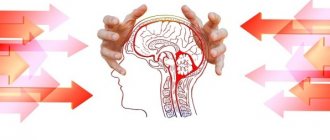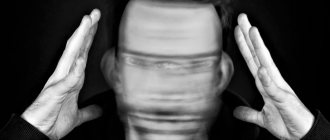Service price
- HOSPITAL Day hospital5 000
- Day hospital with intensive care8,000
- 24-hour hospital (all inclusive, cost per day) 11,000
- 24-hour hospital (all inclusive, cost per day). Single occupancy22 000
- 24-hour hospital (all inclusive, cost per day). Single occupancy in a superior room 33,000
- Primary family counseling for relatives of patients undergoing inpatient treatment free of charge
- Group psychotherapy for relatives of patients undergoing inpatient treatment free of charge
- Group psychotherapy for 24-hour and day hospital patients free of charge
Schizophrenia is a complex mental disorder characterized by multiple personality changes, cognitive decline, loss of touch with reality, and other symptoms. Depending on the characteristics of the course, it is customary to distinguish several forms of the disease, one of which is simple schizophrenia.
A feature of the simple type of schizophrenia is the absence of productive symptoms or a situation where productive symptoms are weakly expressed, that is, the patient does not have delusions, hallucinations, catatonic stupor or agitation, hebephrenia (stupidity) and other signs. The disease affects exclusively negative symptoms. In psychiatry, this type of disease is considered one of the most complex, difficult to treat and has an unfavorable prognosis. Therapy only helps to temporarily smooth out the symptoms of the disease, but over time, patients stop responding to the methods of influence and become regular patients in a psychiatric clinic.
The disease in this form manifests itself quite early, the first age of manifestation is most often 16-20 years old, and affects mainly men. Symptoms develop gradually and generally show similarities to those of other mental disorders.
Another feature of the simple form of schizophrenia is the absence of periods of remission; the disease can take the form of sluggish, moderately progressive or malignant.
Special forms of pathology
A separate group includes special forms of schizophrenia and their individual symptoms, which do not allow them to be classified as any of the above types.
Febrile pathology
Among the special forms of schizophrenia, the febrile form stands out. One of the characteristics indicating the presence of the disease is an increase in temperature. With excitement it increases to 38 degrees, and with stupor - up to 39 degrees. Taking antipyretic drugs does not help lower the temperature.
Sometimes this form is accompanied by clouding of reason. Then it becomes very acute. Providing assistance is initially aimed at complete isolation of the patient.
It happens that the duration of such attacks can reach several weeks.
Protracted pubertal schizophrenia
It appears in adolescence and is characterized by the appearance of one attack, beginning at 11-15 years of age. A teenager's volitional or emotional personality traits are distorted, the concepts of good and evil are lost, and there is a tendency toward antisocial actions.
At the age of 19-20, the condition stabilizes, and starting from the age of 25, a reverse development of personality occurs. During this period, behavioral disorders are smoothed out, behavior ceases to be excessively cruel and aggressive. The only residual effects of the pathology are sudden mood swings and unreasonable, but controlled, outbursts of anger.
Symptoms of simple schizophrenia are:
- Flattened affect is the loss of the ability to express any strong emotions. Patients demonstrate apathy, indifference to everything that is happening, their emotional ties with family and friends are disrupted.
- Deterioration of cognitive functions and decreased intellectual abilities;
- The emergence of strange hobbies and interests: collecting objects, rituals, obsessive actions;
- Abulia is a pathological lack of will, when the patient cannot, through any effort, motivate himself to perform his duties, even the simplest ones, including self-care skills.
- Neglect of appearance and basic hygiene procedures, untidiness, vagrancy;
- Refusal to communicate, breaking ties with friends, social isolation;
- Poor facial expressions and speech, while often retaining the ability to have long, but meaningless conversations with oneself.
The main danger of a simple form of schizophrenia is progressive dementia, when the patient is incapable of banal self-care, loses his ability to work, and can also pose a potential danger to himself and to others, since he shows complete disregard for the simplest safety rules (does not look at the road, may do not turn off the gas, etc.)
Treatment of simple schizophrenia is complex, lengthy and does not always lead to a pronounced effect, since patients with this form show immunity to pharmacological drugs. In addition, taking potent drugs can worsen the patient’s condition when side effects of the drugs are added to the symptoms of the disease.
The ROSA Clinic in Moscow is a private psychiatric hospital and medical institution that offers treatment services for all forms of schizophrenia, including simple schizophrenia, providing its patients with the following set of advantages:
- We use all modern treatment methods, both traditional and new, carefully selecting therapy for each individual patient, taking into account many factors: form of the disease, duration, course characteristics, age, prognosis, severity of the condition, etc.
- Our clinic, one of the few private psychiatric clinics in Moscow, has its own hospital, which allows us to treat patients with varying degrees of disease severity, including aggressive, violent ones who pose a danger to themselves and others.
- The clinic’s psychiatrists use an integrated approach to therapy, which includes both pharmacological treatment with proven drugs that have proven effectiveness, as well as various methods of psychotherapy, physiotherapy, work with relatives, rehabilitation, etc.
- Treatment of schizophrenia at the ROSA clinic is strictly confidential and anonymous, which makes it possible, in the case of a favorable prognosis and outcome, not to register and not have any associated restrictions.
Treatment and prognosis
The basis of treatment for simple forms of schizophrenia is atypical antipsychotics. Neuroleptic drugs are used in small doses. In case of a malignant course of the disease, preference is given to a proven drug - clozapine. The neuroleptic blocks dopamine receptors in the central nervous system and interferes with dopamine transport in the basal ganglia and limbic forebrain. The antipsychotic quickly and effectively eliminates psychomotor agitation, minimizes behavioral disorders, and suppresses disorders of mnestic function. Taking the drug helps to reduce the severity of affect, eliminates aggressiveness, and prevents impulsiveness of behavioral reactions.
, treatment with the antipsychotic amisulpride is advisable . The neuroleptic has a specific sedative effect, manifested by a decrease in pathological reactions to external stimuli, a weakening of the excited state and affective tension, and the reduction of aggressive behavior.
After the symptoms of the disorder have been alleviated, psychotherapeutic treatment . Patients with schizophrenia need help for the normal organization of family relationships. They need moral support from loved ones. A skeptical attitude towards a person’s condition and refutation of the patient’s possibility of adaptation in society by relatives will bring a negative result and will set the person negatively against others.
During the period of remission, sessions of cognitive behavioral psychotherapy . It should be remembered that suggestions through hypnosis, autogenic training, and psychoanalysis are contraindicated in schizophrenia. Such forms of therapy can worsen the mental health of patients, causing exacerbation and progression of symptoms of the disorder.
In most cases, the simple type of schizophrenia becomes chronic . The gradual worsening of disorders, the increase in deficiency symptoms leads to a complete loss of working capacity and the ability to self-care, a global disruption of social adaptation. In the absence of full, long-term treatment, the prognosis for simple schizophrenia is unfavorable: human disability.
Signs of the disease
Often, patients with schizophrenia have many disorders that can be used to identify the disease. What kind of disease is schizophrenia and how does the patient behave? Such a person may have different thoughts from speech, sound hallucinations, and delusions. Patients are often socially isolated due to paranoia, hallucinations, delusions and apathy. Very rarely, schizophrenics can remain silent and stand still. Patients also stop performing normal activities, such as washing their hair or brushing their teeth. A person expresses few emotions, sometimes it will be difficult to understand what he feels. However, these signs are not enough to diagnose a mental disorder.
Disputes over the correct name
For the first time under its “name,” schizophrenia was mentioned in 1908 at the suggestion of E. Bleuler, but many still argue about the correctness of this name. Firstly, Bleuler himself, to be more precise, called the disease “schizophrenia”, since even he, in the distant past, noted an enviable variety of symptoms. Therefore, I doubted whether the disease was a single disease or whether there was a presence, as well as a combination of individual syndromes.
Also, the name itself, which translates as “split of the mind,” which, according to Bleuler, was supposed to emphasize the multiplicity of such signs, eventually became associated among some with dissociative identity disorder, referred to in everyday life as “split personality.”
Despite the fact that, according to the latest European study, schizophrenia closes the top three diseases, the active stage of which leads to disability, the course of the disease is not always associated with an increase in symptoms and exacerbation over time. The most relevant and comprehensive approaches to its treatment, as well as the absence of concealment of the symptoms of the disease, leads to early diagnosis and allows us to question the incurability of the disease or its inevitable progression. This once again confirms the variety of options for the course of the disease and its individual course.
Positive and negative symptoms
So, the main symptoms of schizophrenia can be divided into:
- positive or productive, which indicate that psychosis is present, these include delusional ideas, hallucinations (most often auditory), mental characteristics and changes;
- negative or deficient ones confirm the loss or change of personality traits that are considered normal. These primarily include the emotional-volitional sphere, namely: a decrease or absence of motivation and volitional efforts, a decrease in the brightness of emotional experiences with positive reinforcement, the inability to receive pleasure from anything, a feeling of constant dissatisfaction (which is called anhedonia), restructuring and poverty of speech (which is called alogia). Emotional experiences that are negatively or stressfully reinforced cause an unchanged or even increased emotional response;
- disorganization syndrome, which states that schizophrenia is characterized by chaotic actions, thoughts, actions and speech.
We can also talk about the presence of secondary negative symptoms, which are most often associated with socialization problems. As a rule, it is caused directly by behavior or condition during the acute phase. For example, alienation as a result of paranoid thoughts, frightening the environment, catothymic motor freezes or rash walking.
Schneiderian symptoms
K. Schneider tried to highlight from the entire list of the most common symptoms those that most accurately distinguish schizophrenia from other disorders. He called them “symptoms of the first rank”, and later they became known as “Schneiderian symptoms”. These include:
- delusional idea about the influence of “other” forces on the patient;
- the belief that thoughts are being replaced, forcibly removed, or, conversely, forcibly introduced into the patient’s head;
- suspicion that people can “read” the patient’s thoughts or thoughts themselves can “sound” without human participation and be overheard by others;
- the presence of voices that comment on the patient’s actions and thoughts or several voices that communicate with each other.
As you can see, Schneider reflected well the delusional-hallucinatory side of the disease. However, many other important components were left unattended. Therefore, the presence of the mentioned symptoms will be an addition to the diagnosis, but is not the only measure of the patient’s symptoms.
Diagnosis confirmation
The diagnosis is made based on the symptoms described by the patient and additions made by his relatives and friends. Psychiatric history is also taken into account. Certain signs, symptoms, their severity and duration are taken into account.
A special point is the differentiation of signs that will confirm the diagnosis of schizophrenia and separate it from disorders such as bipolar, major depressive, borderline, schizoaffective. In addition, it is worth excluding an overdose of psychoactive or narcotic substances, adverse reactions from prescribed medications, metabolic disorders, epilepsy, infectious diseases or their complications. Also exclude the dependence of symptoms on brain damage due to injuries or their consequences, neoplasms, changes in blood supply, syphilis, HIV, meningitis. Also check whether the patient’s hallucinations are signs of delirium, somatic illnesses and acute stress disorders.
An important aspect in this case may be a complete clinical examination, which includes a history, a complete and thorough examination, complete blood tests and blood tests for specific infections such as HIV and syphilis. To these are added biochemical examinations that diagnose and take into account the condition and functioning of the liver, kidneys, thyroid gland and endocrine glands, urine analysis, ECG, and drug test.
A separate point worth noting is the fact that hormonal changes in a woman’s body during pregnancy can cause a number of unpredictable conditions. This includes eclampsia in pregnant women and all possible forms of toxicosis. So women should also take a pregnancy test.
At the moment, there are two systems for assessing the patient’s condition when diagnosing schizophrenia: DSI in America and some other countries and ICD in most European countries. Although, it is worth noting that many factors (if not most) coincide.
ICD-10 criteria
According to ICD-10, at least one of the following symptoms must be observed:
- “echo of thoughts”, which is expressed in the sound of one’s own thoughts, manipulation of the patient’s thoughts by strangers, the ability to eavesdrop on the patient’s thoughts by strangers;
- obsession with controlling the body (limbs) or external actions, and control can be manifested both in activity and in freezing; delusional ideas;
- awareness of a voice or voices that comment on the patient’s thoughts, argue with each other, and the voices can be localized in different parts of the body;
- persistent delusion, which is expressed in an obsessive, but inadequate, inappropriate, ridiculous or too pompous idea;
We can also say that a diagnosis can be made if there are at least two, and better yet, more than two persistent symptoms of less pronounced specificity.
- Repeatedly repeated, persistent hallucinations that affect any analyzers (but without vivid affective states) or obsessive overvalued ideas.
- Self-created own words that are constantly used and modified; sudden breaks (blockages) of phrases, which are accompanied by the same stupor of the thought process, and when reminded of a sounding idea, it is not possible to continue the thought; fragmentation and incomprehensible structure of speech.
- Catatonic disorders, such as inappropriate activity, freezing, waxy flexibility. In addition, clearly expressed strange reactions of resistance may be observed, when a person begins to constantly not carry out what is proposed or, conversely, do the opposite, and without the possibility of explaining his protest. For example, a person is asked to sit down, but he, on the contrary, remains standing in one place or is even ready to turn around and go in an unknown direction. Patients may be partially or completely out of touch. The person does not answer questions and does not even make it clear that dialogue is possible. Often there is freezing and a decrease in all reactions, including the response to pain.
- Consistent and clearly noticeable social changes, which are marked by loss of interests, will, and motivation. In addition, interests of any order are lost; the patient and his environment may note the aimlessness of his existence, absorption in his own obsessive experiences. The person becomes absolutely uninterested in social connections and public affairs.
- Apathy, emotional poverty, social alienation and unproductivity, which is not a sign of depression or a consequence of taking any pharmacological forms.
If the noted signs bother the patient or are pointed out by relatives, and their duration is significant (within a month), then a preliminary diagnosis of “acute schizophrenia-like psychotic disorder” is made). If the symptoms persist further, then the diagnosis is reclassified as “schizophrenia.”
If these symptoms are combined with other active symptoms that may indicate other problems, such a definitive diagnosis will not be made.
DSM criteria
According to this classification, it is necessary to have two or more characteristic symptoms, and for at least a month (less can only be if the severity of the symptom was interrupted by therapy):
- rave;
- hallucinations of various forms;
- speech disorders, its abstractness and strangeness of word forms or general structure;
- markedly disorganized behavior, which may be expressed by marked oddness of dress, inappropriate and inappropriate crying and similar or catotonic disorder;
- a negative galaxy of symptoms, reduced to a decrease in the brightness and richness of emotions, silence or impoverishment of speech.
One main symptom also stands out - fantastic hallucinations or the presence of a voice (voices) arguing or commenting on the patient’s behavior and thoughts. It is believed that even one symptom may be sufficient if it is objectively isolated and observed for more than one month.
A speech disorder is classified as a symptom if the changes are pronounced, interfere with communication, cause blocking and loss of train of thought, and give a clear picture of interference when communicating with the patient.
Additionally, other symptoms are considered.
Obvious violations of social connections and professional activities. Over a significant period, more than six months, there were obvious disorders in social contacts, a catastrophic decline in the level of professional achievements and aspirations. This can also include a noticeable deterioration or complete lack of self-care. And, if the disease began in childhood or adolescence, inability to establish social contacts, lack of interest in them, alienation, lack of aspirations and motivation. I would like to emphasize that the components of this order must develop without a significant traumatic event, acute disappointment and abuse of various kinds. And also should not be associated with traumatic brain injuries, disability, reports of a serious illness, neoplasms, infections or other diagnoses.
According to the DSM classification, symptoms must last for at least six months, of which characteristic symptoms must be present in the active phase for at least one month. And in the prodrome and residual phase, at least two should remain in an erased or weakened form.
And, we repeat, depressive and bipolar disorder, drug use, and somatic illnesses are excluded. If a patient has been diagnosed with autism in childhood, to supplement the diagnosis with schizophrenia, it is enough for severe delusions or hallucinations to continue for a month.
It was previously stated that, according to the DSM classification, schizophrenia could be divided into main subtypes:
- a subtype with a predominance of paranoid symptoms: delusions, hallucinations, but with minimal or completely absent cognitive, speech and behavioral disorders;
- the hebephrenic subtype is characterized precisely by a cognitive disorder of a pronounced nature and an affective shift;
- a subtype with a catatonic predominance of symptoms, which includes severe psychomotor disturbances, stupor, waxy flexibility;
- undifferentiated subtype, in which it is difficult to distinguish the predominance of certain symptoms;
- residual subtype, which is characterized by residual positive symptoms, mild but long-lasting.
In our country it is also customary to distinguish separately:
- post-schizophrenic depression, which is an episode with some symptoms of schizophrenia in a weakened form;
- simple schizophrenia, which manifests itself in a sharp worsening of vague negative symptoms;
- senestopathic schizophrenia, which is characterized by a sense of pointless painful sensation over the entire surface of the body, and sometimes even internal organs;
- childhood schizophrenia;
- paranoid schizophrenia, with pronounced paranoia, etc.
However, recently, especially in the American Psychiatric Association, they have been advocating for the abolition of division into subtypes, so as not to complicate the process of coding the disease and to eliminate the need to revise the diagnosis if symptoms are added or changed.
Causes
Factors in the development of simple schizophrenia, as well as mental disorders of the schizophrenia spectrum in general, are variable. A lot of hypotheses have been put forward regarding the origin of the deviation.
Biochemical hypotheses
Dopamine
The main theory of the origin of pathology. According to the views of neurophysiologists, excessive production of the neurotransmitter dopamine provokes the development of chaotic electrical activity of the brain. Treatment in this case comes down to normalizing the level of the substance using pharmacological methods. Opponents of the hypothesis point to the lack of complete recovery with formally normal dopamine levels after treatment.
Serotonin
Proponents point to a major role from insufficient production of serotonin, another neurotransmitter. Still others see simple schizophrenia as the result of excessive synthesis of norepinephrine.
Apparently, biochemical theories have a rational grain, but are not fundamental in pathogenesis and require a trigger mechanism and certain premorbid personality traits.
Biological hypotheses
Organic
Based on studies of the brains of patients with simple schizophrenia and other forms. Mostly with a malignant course. According to supporters, mental disorder is the result of destruction of the cortex and hemispheres. The hypothesis is deservedly doubtful. Because it is not clear whether anatomical disorders develop during the course of the disease or as a result of taking heavy doses of psychotropic drugs.
Genetic
Simple schizophrenia is caused by heredity and the development of cerebral structures. Patients with a strong family history are indeed more likely to develop a mental disorder, suggesting a role for biological factors. But there are many exceptions. In addition, not all children who received brain damage in the prenatal period develop a deviation, this calls into question the logic of the authors.
Psychoanalytic
Proposed by Freud, developed by his followers. According to the opinion, disorders are formed as a result of raising a child in the first years of life. The lack of strict rules and floating requirements lead to fragmentation and duality of thinking. Proponents introduce the concept of a schizophrenic mother, who plays the greatest role in laying down the characteristic features for the formation of the disease.
Autoimmune
Closely related to the biological theory is the theory of autoimmunization. Tissues are destroyed by the body’s own defenses, which leads to the destruction of cerebral structures and entire clusters of nervous tissue.
There are less popular views. Each hypothesis looks at the problem from one side. Without a genetic factor or family history, the risks are lower, but this does not guarantee the absence of the disease in the future. Premorbid traits are required, therefore Freud's theory has a logical basis. A change in the level of neurotransmitters is rather the last straw for the development of the foundation of simple schizophrenia. For the process to begin, a trigger is required.
These are:
- Past illnesses. It doesn’t matter what, even a cold. Even more difficult.
- Psychotraumatic situation. From domestic violence to the death of a relative or loved one. Unrequited love interest, bad relationships with peers, bullying at school.
- Long-term social isolation for various reasons. Including the period of immobilization after an injury or illness.
Patients with pronounced premorbid features should learn relaxation techniques and avoid traumatic events. The causes are not fully understood, which makes diagnosis difficult and treatment symptomatic.
Difficulties in diagnosing the disease
There are no uniform rules for defining schizophrenic disorder. The doctor most often relies on his own experience and knowledge, rather than on the objective criteria for making a diagnosis, which are recorded in the International Classification of Diseases. The most difficult time to make a diagnosis is at the initial stage of the disease. The variety of clinical manifestations, their slow progression, and the variety of options for the development of the disease make it difficult to make a diagnosis.
Diagnostics is carried out in several stages.
- At the first stage, a somatoneurological examination is carried out, during which laboratory tests of cardiac function and brain activity are carried out, tests to assess the functioning of the glands and the production of hormones. Conversations are conducted with the patient, interviews with his relatives and close people.
- The second and subsequent stages consist of monitoring the course of the disease, assessing the dynamics of the patient’s condition, detecting microsymptoms (changes in muscle tone, reflexes, etc.) and newly emerging signs of the disease.
There are often cases when the patient and his relatives deny the presence of pathology or overly dramatize the changes that are occurring. A doctor cannot make an accurate diagnosis, relying only on the patient’s current mental state and the dynamics of the disease recorded in medical documents.
Diagnosis F 20.4 Post-schizophrenic depression
A depressive episode, which can be long-lasting, occurring as a consequence of schizophrenia. Some symptoms of schizophrenia (“positive” or “negative”) may still be present, but they no longer dominate the clinical picture. These depressive conditions are associated with an increased risk of suicide. If the patient no longer shows any symptoms of schizophrenia, a diagnosis of a depressive episode should be made (F32.-). If the symptoms of schizophrenia are still vivid and clear, a diagnosis of the appropriate type of schizophrenia (F20.0-F20.3) should be made.
Diagnosis F 20.3 Undifferentiated schizophrenia
A psychotic condition that meets the basic diagnostic criteria for schizophrenia, but does not correspond to any of its forms classified in subheadings F20.0-F20.2, or exhibits features of more than one of the above forms without a clear predominance of a specific set of diagnostic characteristics.
Antitypical schizophrenia
Excluded:
- acute schizophrenia-like psychotic disorder (F23.2)
- chronic undifferentiated schizophrenia (F20.5)
- post-schizophrenic depression (F20.4)
Diagnosis F 20.1 Hebephrenic schizophrenia
A form of schizophrenia in which affective changes dominate. Delusions and hallucinations are superficial and fragmentary, behavior is absurd and unpredictable, usually mannerisms. The mood is changeable and inadequate, thinking is disorganized, speech is incoherent. There is a tendency towards social isolation. The prognosis is usually unfavorable due to the rapid increase in “negative” symptoms, especially affective flattening and loss of will. Hebephrenia should only be diagnosed during adolescence and young adulthood.
- Disorganized schizophrenia
- Hebephrenia











